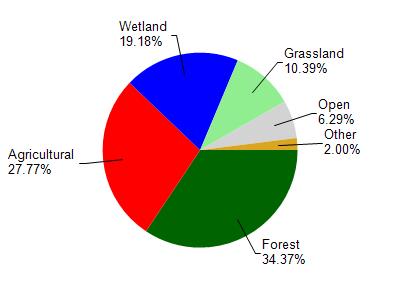Waushara
No
No
No
Fish and Aquatic Life
Overview
Napowan Lake (Funk), in the Pine and Willow Rivers Watershed, is a 52.12 acre lake that falls in Waushara County. This lake is managed for fishing and swimming and is currently not considered impaired.
Date 2011
Author Aquatic Biologist
Historical Description
Source: 1970, Surface Water Resources of Waushara County Napowan (Funk) Lake T-19-N, R-11-E, Section 2
A moderate sized, hard water, seepage lake located about three and one-half miles southwest of Saxeville. The littoral bottom materials consist mostly of sand. The lake has a very steep basin, with only about three percent of the depth less than three feet. The major fishery consists of northern pike, largemouth bass, and various panfish, with bluegill and black crappie the most common species. Fish surveys conducted in 1962, 1966, and 1968 indicate a general decline in the condition of the fishery in this lake. Although the largemouth bass population is doing quite well, the surveys show that planted northern pike are present, but little or no natural reproduction is taking place. The large bluegill population is slow growing. Partial chemical treatment to reduce the size of the bluegill population is being considered at the present time for management purposes. The lake offers limited habitat for nesting bluewing teal and a resting place for some migrating puddle ducks. Hunting is allowed with permission. Fluctuating water levels and algae are major use problems. Camp Napowan is located at the north end of the lake. Public access is limited to one access road without parking. There are 21 cottages or dwellings present.
Surface Acres = 50. 62; S.D.F. = 1.33; Maximum Depth = 17.5 feet
Date 1970
Author Surface Water Inventory Of Wisconsin
General Condition
Napowan Lake (Funk) (190200) was assessed during the 2016 listing cycle; total phosphorus sample data were clearly below 2016 WisCALM listing thresholds for the Recreation use and Fish and Aquatic Life use. This water was also assessed for chlorides and sample data were clearly below 2016 WisCALM chronic and acute listing criteria for the Fish and Aquatic Life use. This water is meeting these designated uses and is not considered impaired.
Date 2015
Author Ashley Beranek
Condition
Wisconsin has over 84,000 miles of streams, 15,000 lakes and milllions of acres of wetlands. Assessing the condition of this vast amount of water is challenging. The state's water monitoring program uses a media-based, cross-program approach to analyze water condition. An updated monitoring strategy (2015-2020) is now available. Compliance with Clean Water Act fishable, swimmable standards are located in the Executive Summary of Water Condition in 2018. See also the 'monitoring and projects' tab.
Reports
Management Goals
Wisconsin's Water Quality Standards provide qualitative and quantitative goals for waters that are protective of Fishable, Swimmable conditions [Learn more]. Waters that do not meet water quality standards are considered impaired and restoration actions are planned and carried out until the water is once again fishable and swimmable
Management goals can include creation or implementation of a Total Maximum Daily Load analysis, a Nine Key Element Plan, or other restoration work, education and outreach and more. If specific recommendations exist for this water, they will be displayed below online.
Monitoring
Monitoring the condition of a river, stream, or lake includes gathering physical, chemical, biological, and habitat data. Comprehensive studies often gather all these parameters in great detail, while lighter assessment events will involve sampling physical, chemical and biological data such as macroinvertebrates. Aquatic macroinvertebrates and fish communities integrate watershed or catchment condition, providing great insight into overall ecosystem health. Chemical and habitat parameters tell researchers more about human induced problems including contaminated runoff, point source dischargers, or habitat issues that foster or limit the potential of aquatic communities to thrive in a given area. Wisconsin's Water Monitoring Strategy was recenty updated.
Grants and Management Projects
Monitoring Projects
| WBIC | Official Waterbody Name | Station ID | Station Name | Earliest Fieldwork Date | Latest Fieldwork Date | View Station | View Data |
|---|
| 190200 | Lake Napowan | 704008 | Napowan Lake - Deepest Part-Ep | 8/14/1979 | 11/24/2025 | Map | Data |
| 190200 | Lake Napowan | 10040978 | Napowan Lake - Monitoring Well | 8/16/2013 | 12/15/2018 | Map | Data |
| 190200 | Lake Napowan | 703020 | Napowan Lake - Deepest Part-Ep | 2/10/1977 | 7/11/2003 | Map | Data |
| 190200 | Lake Napowan | 10007434 | Lake Napowan | 6/1/1993 | 7/30/2019 | Map | Data |
| 190200 | Lake Napowan | 10019243 | Lake Napowan -- Access | 5/21/1985 | 7/16/2019 | Map | Data |
|

Watershed Characteristics
Lake Napowan is located in the Pine and Willow Rivers watershed which is 302.08 mi². Land use in the watershed is primarily forest (34.40%), agricultural (27.80%) and a mix of wetland (19.20%) and other uses (18.70%). This watershed has 377.48 stream miles, 11,273.01 lake acres and 33,136.61 wetland acres.
Nonpoint Source Characteristics
This watershed is ranked High for runoff impacts on streams, Not Ranked for runoff impacts on lakes and High for runoff impacts on groundwater and therefore has an overall rank of High. This value can be used in ranking the watershed or individual waterbodies for grant funding under state and county programs.However, all waters are affected by diffuse pollutant sources regardless of initial water quality. Applications for specific runoff projects under state or county grant programs may be pursued. For more information, go to surface water program grants.